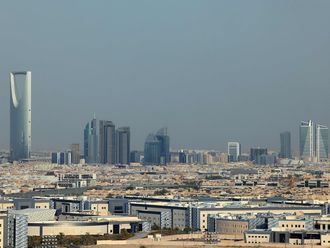Dubai: Last week the Dubai Financial Market General Index (DFMGI) got hit hard, falling 110.06 or 3.62 per cent to end at 2,928.17. That’s its largest one-week decline since early November 2017. Weakness was widespread as there were only five advancing issues against 31 declining. Volume was up slightly from the previous week even with the shortened four-day trading week due to the Eid holiday.
This is not the type of market behaviour that provides confidence to the bulls. Following a weak close two weeks ago (bottom quarter of the week’s range) last week’s decline saw the DFMGI fall below the low for each of the previous four weeks and close at a five-week low. Rather than providing support to the possibility that a long-term bottom is forming, last week’s performance increases the chance for a continuation of the eight-month downtrend. Nevertheless, it remains to be seen whether it is part of a continuous process of a developing bottom or a precursor to a bear trend continuation. Investors need to be prepared for either at this point.
A daily close below the most recent low of 2,870.07 signals a bearish continuation of the trend. However, there is a potential support zone a little lower, from around 2,851 to approximately 2,826. That zone consists of previous monthly support and the confluence of several price levels from multiple Fibonacci ratio analysis measurements. Fibonacci ratio analysis calculates possible support levels by using prior swings. When multiple measurements identify a similar price area that area is considered to have greater significance as a possible support zone.
Further down is the 2,815 price zone. This is a target zone from the breakdown of a large head and shoulders top reversal pattern that formed in the DFMGI throughout much of 2016 and 2017. A breakdown from this classic top formation occurred in early-February as the index fell below 3,326.
If, instead of falling further the index is able to hold above the 2,870.07 price area we can anticipate a choppy consolidation phase that occurs around the lows as part of a bottoming process. At this point the index would have to close above the 3,109.30 high from two weeks ago before there is a clear sign that buying pressure is increasing. That swing high is now part of the series of lower swing highs over recent months that makes up the downtrend structure.
Abu Dhabi
The Abu Dhabi Securities Exchange General Index (ADI) dropped by 179.47 or 3.81 per cent to close at 4,535.26, the largest one-week decline since early February 2017. Market breadth was also bearish with only five advancing issues and 24 declining, while volume fell to its lowest level in about 10 months.
At last week’s low of 4,494.02 the ADI had fallen 5.3 per cent from its most recent high of 4,745.23 hit seven days ago. That swing high ended a 7.5 per cent rally off the prior swing low from late-May and was an attempt at a multi-year breakout into new trend highs, reaching the highest price level since August 2017. The index was able to close on a daily basis at a new trend high (above prior high of 4,721.62 from mid-April) for two days in a row, but it quickly failed leading to the 5.3 per cent decline.
What we’ve been seeing in the ADI for the past several months or so is the earlier stage of a broadening consolidation pattern where multiple day and weekly swings start relatively smaller and then get wider as the range expands over time. If this pattern continues to progress then a breakout to a new high is not reliable as to whether the move will continue, and a breakdown below the consolidation range does not assure a continuation to the downside. Currently, support of the pattern is at 4,414 and resistance is at 4,745.23. More choppy up and down moves can be anticipated as this broadening formation continues to evolve.
Stocks to watch
While the wider market was mostly down last week Aramex was an exception. The stock was the third best performer in Dubai, up 0.10 or 2.6 per cent to close at 4.00. Since hitting a high of 5.50 in early-March 2017 Aramex has corrected as much as 32.4 per cent as of the most recent swing low of 3.72 reached four weeks ago. During the corrective phase Aramex has been able to maintain its long-term uptrend price structure of a series of higher swing highs and higher swing lows. It is now working its way off the 3.72 low.
A breakout and subsequent daily close above the seven-week high of 4.07 will signal a bullish continuation of the bounce and counter-trend rally with the first target zone around the swing high of 4.40. The next key price zone is then the February swing high of 4.75. If Aramex can close above that swing high on a daily basis then the possibility for a continuation of the uptrend improves.
On the downside, a drop below last week’s low of 3.85 shows short-term weakness with the 3.72 low more likely to be tested and possibly exceeded. The bull case is cancelled on a daily close below that low.
Bruce Powers, CMT, is a technical analyst and global market strategist.











